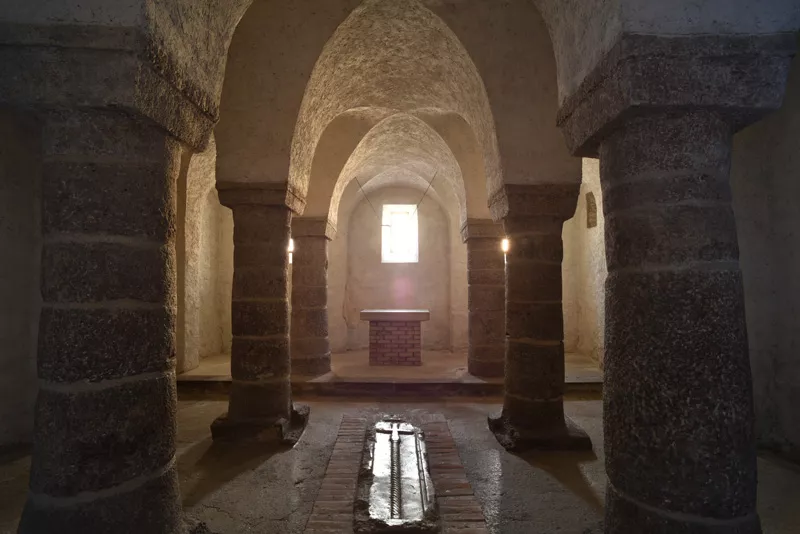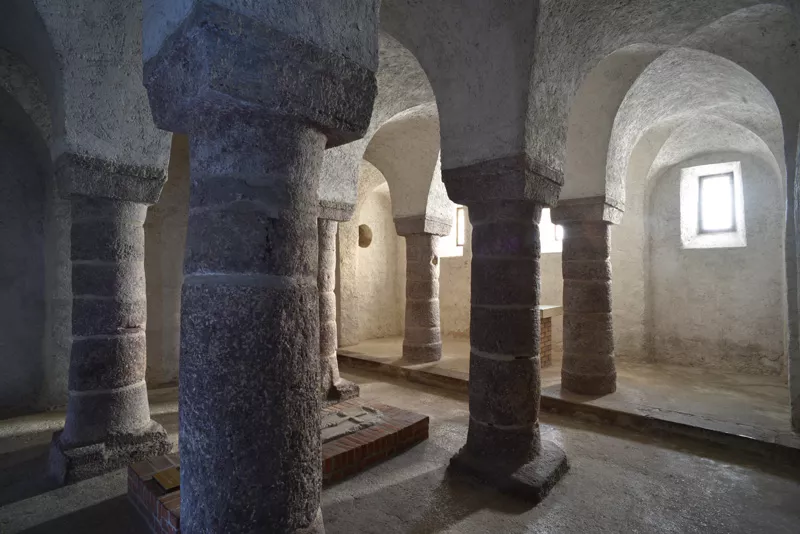On April 30, 2021, archaeological excavations and historical research began into the walls of the Royal Crypt at Tihany Abbey. The project entitled Multidisciplinary Research into the Royal Crypt of Tihany, was initiated by the Eötvös Loránd Research Network (ELKH), which also funded the work. As part of the project, experts will carry out exploratory excavation and wall research under the coordination of the ELKH Research Centre for the Humanities (ELKH BTK) and the involvement of other institutions.
Partial archaeological and historical research in the Royal Crypt, also known as the 'Tihany Undercroft', also took place in 1953 and in the 1990s but left several important questions about the 11th-century building and the tombs of its founders unanswered. These include the form of the medieval church, the Royal Crypt and its architectural relationship to the medieval church, and the originality and possible subsequent modifications to the crypt vault. In addition to these questions, there are also doubts about the tombs of King Andrew I of Hungary and Prince David, and the dating and interpretation of other tombs previously excavated in the crypt. It is not clear which phase of the crypt burials the human remains buried under a tombstone in the middle of the square that was relocated 1953 represent: the researchers are looking to resolve this question using the carbon isotope dating method.

The excavation works are led by Ágoston Takács, lead archaeologist, and the project is led by Professor Kornél Szovák, a member of the College of Humanities and Social Sciences at the ELKH Scientific Council and leader of the ELKH BTK Gyula Moravcsik Institute. The professional work is assisted by an advisory board, whose members are preeminent experts in the fields of Hungarian archeological and art historical research. The chairman of the body is Balázs Balogh, the director general of ELKH BTK, and the honorary chairman is Jeromos Mihályi, the governor of the Benedictine abbey. Researchers from ELTE BTK, PPKE BTK, as well as researchers from the King Matthias Museum of the Hungarian National Museum in Visegrád and the staff of the Dezső Laczkó Museum in Veszprém will also contribute to the work. The research is carried out with the full support and active cooperation of the Benedictine Abbey of Tihany. The archaeological work will be planned by specialists for a period of one month, although the final restoration and related planning is expected to take much longer.

The researchers plan to report on the process of archeological excavation and the progress of the research every Friday, which can be followed in the form of a short film on the YouTube channel of the Benedictine Abbey of Tihany and on the websites of ELKH and BTK.
In early June, after the archaeological excavations have been completed, the press will have the opportunity to tour the site for the first time under the guidance of excavation specialists. Once the excavations are complete, the excavated Royal Crypt will be open to the public as part of the abbey museum tour.
* * *
About the Royal Crypt of Tihany and its use to date
Andrew I of Hungary (1046–1060), the fourth Hungarian king, founded a Benedictine abbey named after the Virgin Mary and Bishop St. Ányos on a prominent point on the Tihany Peninsula in 1055 to serve as a burial place for himself and his family on the east side of the church. In 1060, the ruler was laid to rest here, and was later joined by his son, Prince David. The medieval church was demolished in the early 18th century. Using the identical building materials, the two-tower baroque church seen today was built between 1719 and 1754. The sanctuary was built over the 11th century intact royal crypt.
The Benedictine Abbey of Tihany was nationalized in 1950, when monastic orders were dissolved in Hungary. In September 1953, a rapid archaeological excavation was carried out in the Royal Crypt, then known as the 'catacomb' and later the 'undercroft'. The form of Tihany's undercroft we see today was shaped at that time, with an 11th-century limestone slab in the middle of the southern wall depicting a processional cross with a twisted handle, which presumably covers a royal tomb. Behind the tomb were placed the bone remains thought by the anthropologist Mihály Malán to belong to the oldest burials of the Royal Crypt.

About 150,000 people visit the ancient sanctuary and the abbey museum each year. A community of 12 monks hold monk prayer classes in the Royal Crypt during the Easter holidays, and also hold a mass for the spiritual salvation of the royal family on November 29 – the feast of St. Andrew the Apostle. Orthodox church organization following the Byzantine rite also regularly perform the Holy Liturgy in the Baroque (Upper) Church and the Royal Crypt. In the 11th century, Hungary lay at the meeting point of Eastern and Western Christianity, and King Andrew I grew up in the Grand Duchy of Kiev, where he married Anastasia, daughter of Grand Prince Yaroslav the Wise. In the summer, the Royal Crypt is the main venue for the Lights of Dawn and Sounds of Silence, two highly successful programs organized by the Budapest Long Stride walking group. Student groups, church school groups and Hungarian groups from outside the country's borders regularly surround the royal tomb, place a wreath and then sing the Hymn or the old national anthem beginning with Our Lady of the Blessed Virgin.
The charter of Tihany issued by King Andrew I is the first written memory of the Hungarian language. It is a fragmented relic, as the Latin text describing the estates belonging to the Benedictine Abbey of Tihany contains the first Hungarian words and the phrase "feheruuaru rea meneh hodu utu rea", which means "the path to war and Fehérvár"). The document is kept in the Archives of the Archabbey of Pannonhalma. Abbot Ágoston Lécs of Tihany (1740–1760) – the builder of the two-tower baroque church – was fond of declaring that the abbey church was built on a "supra firmam petram", i.e. "solid rock". This rock foundation will be exposed during the excavation.